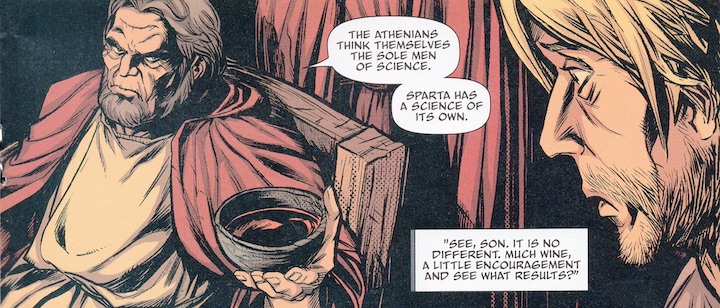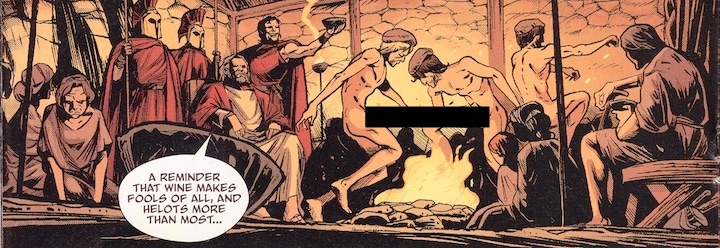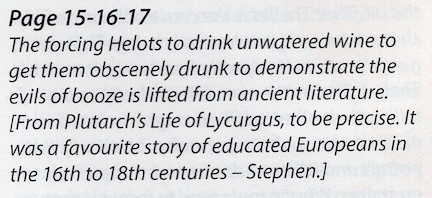
July 9, 2020, by Lynn Fotheringham
Drunken Helots
(Διαβάστε στα Ελληνικά.) (Revised 10/08/20.)
CONTENT: ANCIENT GREEK SLAVERY, ABUSE OF THE ENSLAVED
For anybody who doesn’t know the book, Three (by Kieron Gillen and Ryan Kelly) is a graphic novel/comic set in fourth-century B.C.E. Sparta, over a hundred years after the more famous events of the Greco-Persian wars such as the battle of Thermopylae. Rather than simply glorifying the famous Spartan warriors, the story focuses on three of the Spartans’ enslaved class, the Helots. Although a couple of attested historical characters are mentioned, the action is all invented – inevitably, as we know so little about the lives of the Helots that no story could be told about them as individuals based on the sources. Nevertheless, Three is deeply informed by the ancient sources, and uses their fragmentary evidence in clever ways.
In chapter/issue 1, an ephor (elected Spartiate magistrate) and his retinue arrive unexpectedly at a Helot farmstead, seeking refuge from the rain. Later that evening…

THREE, ch./issue 1, p.15 bottom

THREE, ch./issue 1, p.16 top
Here’s what writer Kieron Gillen (and historical consultant Stephen Hodkinson) had to say about this in the ‘Historical Footnotes’ included at the back of the collected edition:

THREE, historical footnote
And for those who are interested, here’s the very piece of Plutarch – who was writing (in the late first/early second century C.E.) a biography of the legendary Spartan law-giver, Lycurgus:
28. (4) Καὶ τἆλλα δὲ τραχέως προσεφέροντο καὶ σκληρῶς αὐτοῖς, ὥστε καὶ πίνειν ἀναγκάζοντες πολὺν ἄκρατον εἰς τὰ συσσίτια παρεισῆγον, ἐπιδεικνύμενοι τὸ μεθύειν οἷόν ἐστι τοῖς νέοις. καὶ ᾠδὰς ἐκέλευον ᾄδειν καὶ χορείας χορεύειν ἀγεννεῖς καὶ καταγελάστους, ἀπέχεσθαι δὲ τῶν ἐλευθέρων. |
28. (4) And in other ways also they were harsh and cruel to the Helots. For instance, they would force them to drink too much strong wine, and then introduce them into their public messes, to show the young men what a thing drunkenness was. They also ordered them to sing songs and dance dances that were low and ridiculous, but to let the nobler kind alone. |
- Text and translation by Bernadotte Perrin, Loeb Classical Library vol.46, 1914.
The scene in Three is an ingenious adaptation of this snippet from Plutarch to fit the new narrative: it transfers the practice of making the Helots drunk from the public messes in Sparta to a farmstead in rural Lakonia; at the same time, it maintains the sense of the practice as a scientific/educative one. The incident also does more than simply illustrate the nature of the relationship between the Spartiates and the Helots; it is pivotal to the story. Because one of the drunken Helots just cannot keep his mouth shut…
I highly recommend Three both as a graphic novel and as a presentation of ancient Sparta. In addition, I am currently conducting audience-research around this work, including an ‘on-line reading group’, which you can participate in either by tweeting with the hash-tag #3helots or by commenting below or on my posts at the Departmental blog.
NOTE: I may refer to/quote comments on this post either in later blog-posts or in a research publication. More information about the project, including a Privacy Notice and ways of getting hold of the book.
Extracts from Three © 2013 Kieron Gillen & Ryan Kelly. Used with permission.
Photo by Lynn Fotheringham.
No comments yet, fill out a comment to be the first

Leave a Reply